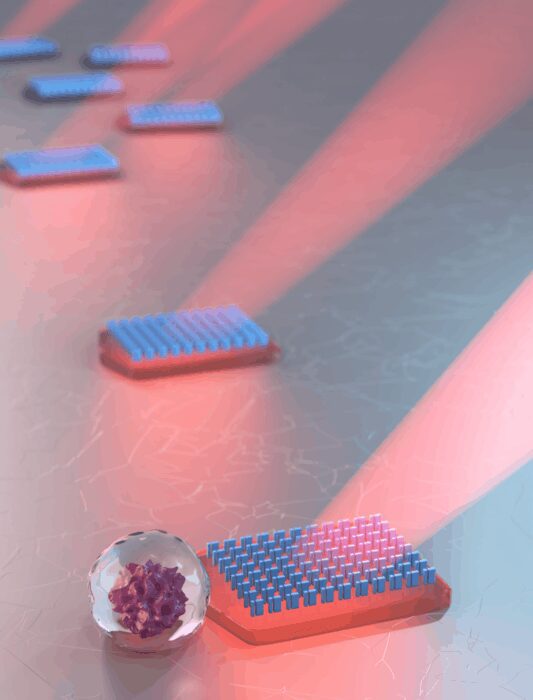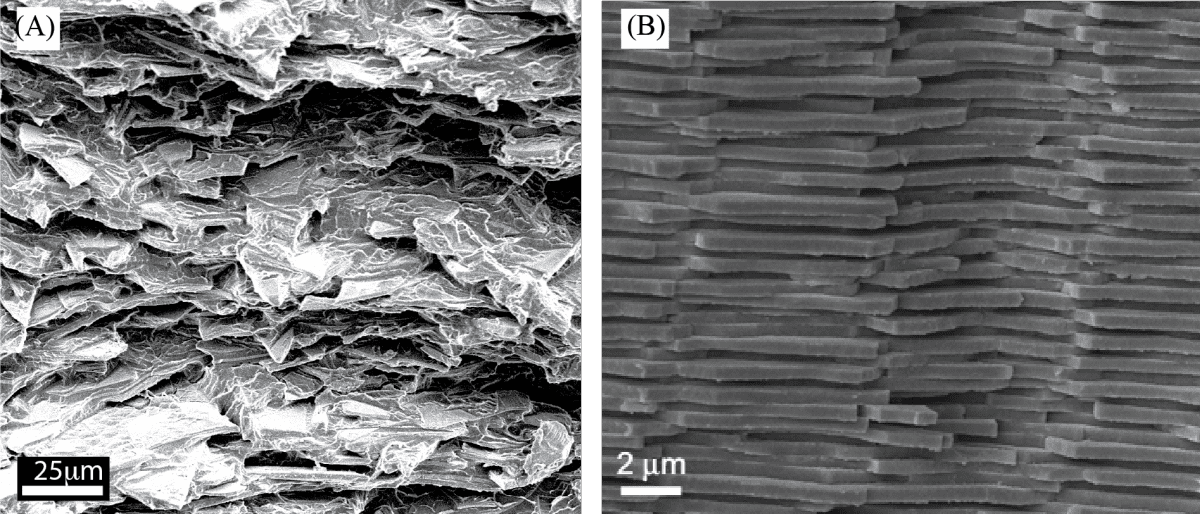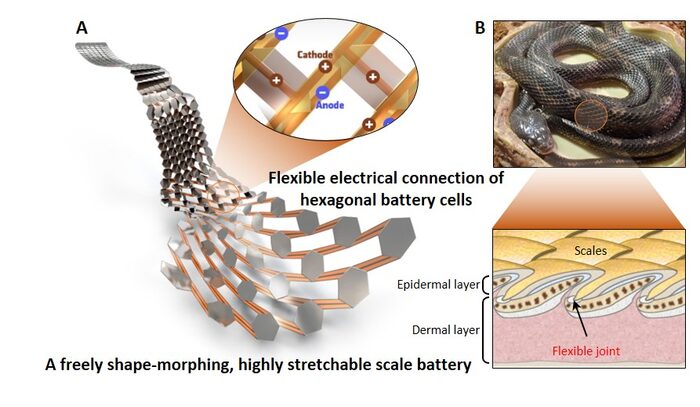
Unfocused light can be used to maneuver microscopic particles in a controlled manner. ?
Illustration: Denis Baranov
Researchers from Chalmers University of Technology, Sweden, have succeeded in creating tiny vehicles powered by nothing but light.
By layering an optical metasurface onto a microscopic particle, and then using a light source to control it, they succeeded in moving the tiny vehicles in a variety of complex and precise ways – and even using them to transport other objects.?
Light has an inherent power to move microscopic objects – a property previously used to develop the Nobel prize winning research idea of ‘optical tweezers’, which use a highly focused laser beam to control and maneuver tiny particles with incredible precision.
Now, a research group at Chalmers University of Technology and the University of Gothenburg has shown how even an unfocused light can be used to maneuver microscopic particles in a controlled manner. Their research was recently published in the journal Nature Nanotechnology. ?
The researchers manufactured vehicles at a scale of 10 micrometres wide and 1 micrometre thick – one thousandth of a millimetre. The vehicles consisted of a tiny particle, coated with something known as a ‘metasurface’. Metasurfaces are ultra-thin arrangements of carefully designed and ordered nanoparticles, tailored to direct light in interesting and unusual ways. They offer fascinating possibilities for use in advanced components for optical applications such as cameras, microscopes and electronic displays. Usually, they tend to be thought of as stationary objects, with their use being seen as the ability to control and affect light. But here, the researchers looked at it the other way around, investigating how the forces resulting from the light’s change in momentum could be used to control the meta-surface.
Like two pool balls colliding
The researchers took their microscopic vehicles, which they termed ‘metavehicles’, and placed them on the bottom of a water dish, then used a loosely focused laser to direct a plane wave of light onto them. By a purely mechanical process – the heat generated by the light plays no part in the effect – the vehicles could then be moved in a variety of patterns. By adjusting the intensity and polarisation of the light, the researchers succeeding in controlling the vehicles’ movement and speed with a high level of precision, navigating them in different directions and complex patterns, such as figures of eight.
“According to Newton’s third law, for every action there is an equal and opposite reaction – this means that when the light hits the meta-surface, and is deflected in a new direction, the meta-surface is also pushed away in the other direction. Imagine playing pool, when two balls hit each other and bounce off in different directions. In this case, the photons and the meta surface are like those two pool balls,” explains Mikael Käll, Professor at the Department of Physics at Chalmers University of Technology, co-author of the article and leader of the research project.
Transporting other small objects
“The metavehicles were stable, and their navigation was highly predictable and controllable. With advanced automated feedback systems, and more sophisticated control of the intensity and polarisation of the source light, even more complex navigation would be possible,” explains Daniel Andrén, formerly of the Department of Physics at Chalmers and lead author of the study.
The researchers also experimented with using the metavehicles as transporters, to push small particles around the tank. The metavehicles proved capable of transporting objects including a microscopic polystyrene bead and a yeast particle through the water with ease. They even succeeded in pushing a dust particle 15 times the size of the metavehicle itself.
At the moment, the practical applications of this discovery may be a way off. But the fundamental nature of the research means that its value may not yet be evident.
“In the exploration of optical forces, there are many interesting effects that are not yet fully understood. It is not applications that drive this type of research, but exploration of the different possibilities. In a number of different stages ahead, you never know what will happen. But the fact that we showed how the metavehicles can be used as transporters is the most initially promising potential application, for example to move particles through cell solutions,” explains Mikael Käll.
Original Article: Microscopic metavehicles powered by nothing but light
More from: Chalmers University of Technology | University of Gothenburg
The Latest Updates from Bing News & Google News
Go deeper with Bing News on:
Metavehicles
- META Lock Codes (May 2024)on May 8, 2024 at 2:05 am
Kristina Timotic is a Codes Staff Writer who prides herself on her research abilities. No code will remain unredeemed on her watch! When she's not forced to watch Masha and the Bear with her ...
- Vehicles Newson May 5, 2024 at 5:00 pm
Apr. 11, 2024 — Despite their great trust in the on-board autopilot, bridge officers do not believe that autonomous ships will make shipping safer. Moreover, the greater the professional ...
- Meta Quest Promo Codeson May 3, 2024 at 5:01 pm
Molly Higgins is a product/content reviewer and contributing producer at WIRED. She graduated with a bachelor’s degree in English from UCLA and an MFA in creative nonfiction writing from the ...
- Meta Platforms Inc Class A METAon May 2, 2024 at 7:52 am
We sell different types of products and services to both investment professionals and individual investors. These products and services are usually sold through license agreements or subscriptions ...
- Most And Least Expensive Vehicles To Insure 2024on May 2, 2024 at 12:44 am
What Makes a Vehicle Expensive to Insure? What you pay for car insurance is partially based on the vehicle you’re insuring. This factors in claims that have been paid for similar models. For ...
Go deeper with Google Headlines on:
Metavehicles
[google_news title=”” keyword=”metavehicles” num_posts=”5″ blurb_length=”0″ show_thumb=”left”]
Go deeper with Bing News on:
Metasurfaces
- Augmented Reality Slims Down With AI and Hologramson May 9, 2024 at 1:00 am
Summary Researchers have developed wearable full-color 3D augmented reality (AR) displays as light and comfortable as eyeglasses, using artificial intelligence, optical metasurfaces, and holography to ...
- SkyWater Technology Reports First Quarter 2024 Resultson May 8, 2024 at 12:44 pm
SkyWater Technology, Inc. (NASDAQ: SKYT), the trusted technology realization partner, today announced financial results for the first quarter 2024 ended March 31, 2024.
- New Harvard Technology Paves the Way for Advanced Machine Visionon May 6, 2024 at 3:21 pm
Scientists have developed a compact, single-shot, and complete polarization imaging system using metasurfaces. Think of all the information we get based on how an object interacts with wavelengths of ...
- Researchers unveil single-shot and complete polarization imaging system using metasurfaceson May 2, 2024 at 8:03 am
Think of all the information we get based on how an object interacts with wavelengths of light—aka color. Color can tell us if food is safe to eat or if a piece of metal is hot. Color is an important ...
- Unveiling a polarized world -- in a single shoton May 1, 2024 at 5:00 pm
By using just two thin metasurfaces, the imaging system could unlock the vast potential of polarization imaging for a range of existing and new applications, including biomedical imaging, augmented ...
Go deeper with Google Headlines on:
Metasurfaces
[google_news title=”” keyword=”metasurfaces” num_posts=”5″ blurb_length=”0″ show_thumb=”left”]









